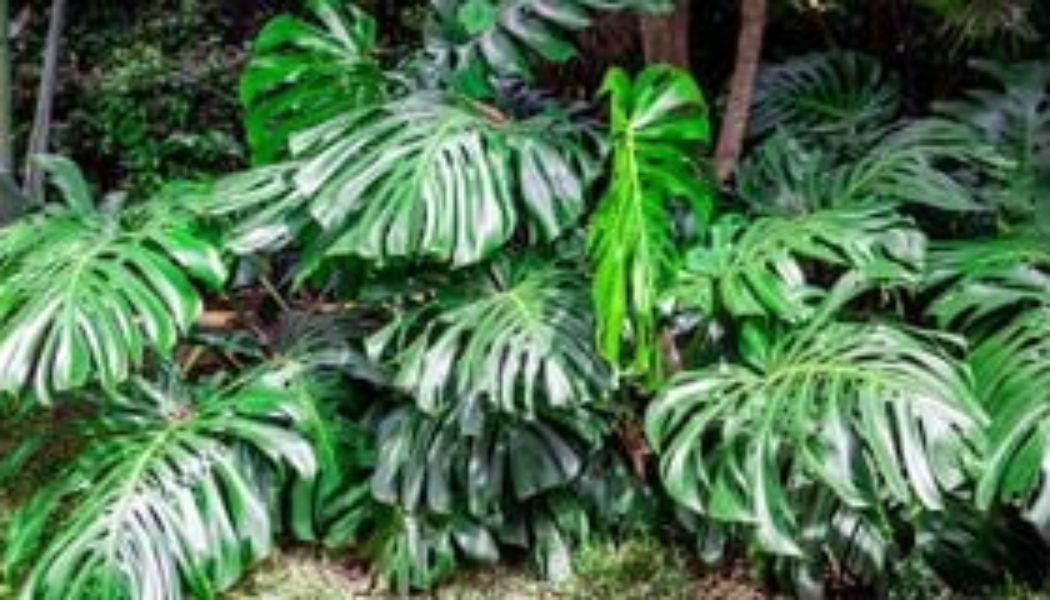Her love for flowers and plants is evident. Even a collection of photos on her mobile phone gallery cannot truly capture the beauty of her charming mixed garden.
At Betty Kibaara’s home in Nairobi’s Karen, it feels like walking through a mini-Eden of colours. On a Friday afternoon, I am thrilled to spend time with her in this vibrant garden.
A gate opens to a townhouse, part of an investment that has been cultivated over the years, with a beautiful driveway. The breeze on the grounds is cool, making you want to spend the rest of your life in this place.
The boundary wall caught my eye. It has been a while since I have seen it in a city fast-rising with skyscrapers and dots of greenery. Garden lovers loathe concrete jungles.
“When I bought the house in 2016, the land was bare. The concrete wall stood out. My mother even suggested I buy a house in Kileleshwa, but I told her to relax. I already knew what I wanted to do with the space,” says Betty.
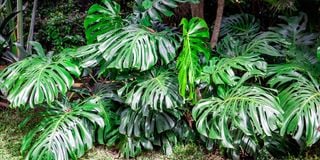
Monsteras at Betty Kibaara’s garden on May 31, 2024 at Kerarapon in Kajiado county.
Photo credit: Billy Ogada | Nation Media Group
Seven years later, the one-acre piece of land has transformed magnificently into a serene environment.
“We were looking for a serene environment away from the hustle of the city. A quiet and peaceful place. A landscaper charged me Sh600,000 which was so expensive, so I bought his plan and got one of the flower men from Ngong Road to help me,” she says.
Betty’s home is now beautifully adorned with a climbing fig that has brought nothing but peace and beauty for seven years. To soften the hard surfaces, a blend of art stands out. The artist has combined bold splashes of colour with lush plants, making the wall almost unnoticeable.
“I love the climbing fig because it greens my wall and turns the concrete jungle into a fruit forest,” says Betty.
Our tour of the garden begins in her front yard, where she has over 200 varieties of flowers and plants, either planted in the ground or potted.
In the past 20 years, two things have driven her mixed gardening.
“I grew up in a village where we didn’t have to buy onions. We could just go behind the house and pick some. So I have a farming background,” she says.
“I’m also a healthy eater and I like to produce my food. I like to grow things and eat them. That way I am sure they don’t have chemicals,” says the 50-year-old who doesn’t look a day older than 40.
Every mini-Eden has a waterfall and Betty has beautifully installed hers outside the front door.
“When Covid-19 struck people were locked indoors. When I contacted a plumber, she quoted Sh100,000. Thanks to YouTube, I saved my money and got exactly what I wanted done,” she says.
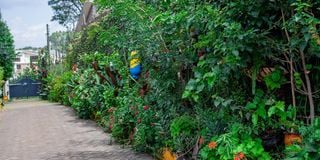
Betty Kibaara’s drive way in Kerarapon, Kajiado County on May 31, 2024.
Photo credit: Billy Ogada | Nation Media Group
In the front garden, the clusters of plants such as jade, African daisies, cactus, ferns, air plants, berries, and birds of paradise provide colour.
She is working on adding healthier trees to the garden, and the soursop represents this effort. It is the fruit of Annona muricata, a deciduous flowering evergreen tree known for its antioxidant, anti-cancer, and anti-malarial properties.
Her first plant, the geranium, is in bloom.”I love it because it does well all year round, but it doesn’t like rain,” says Betty.
Along the driveway, she has a mix of pink, white, and red roses, beautifully blending into the space.
“I planted them last year in memory of my late mum Rose Mary. Every time I feel and smell the roses I remember that she is in a good place,” she says.
This is also one of her favourite spots because it hosts her best flower. Fuchsia – the brightest pink-purple, native to America and New Zealand, and commonly grown as an ornamental.
“I like to put it in a glass of water and see how it floats on the water. I call it the floating fuchsia,” says Betty.
The backyard is a showstopper, featuring a relatively small, manicured lawn and a variety of plants in hanging pots.
Some of the plants include monstera, gooseberry, traveller’s palm, ponytail, and golden palm. Anthurium, a high-end flower with heart-shaped spathes that symbolise affection, making it a perfect alternative to traditional red roses, is also at home in the backyard garden.
Additionally, the garden features the moonflower, which is loved by bees and has a lovely fragrance that is only noticeable at night.
“I planted grass many times before I found out that different grasses grow well in different climates, in shade, and in direct sunlight,” she says.
The garden also boasts fruit-bearing plants such as grapes, avocados, cherry guavas, and oranges, completing this wonderful mix.
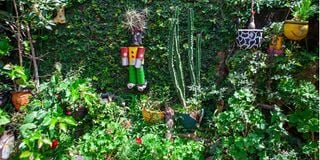
A variety of plants at Betty Kibaara’s garden in Kerarapon, Kajiado County on May 31, 2024.
Photo credit: Billy Ogada | Nation Media Group
“The grapes are doing very well, so we are going to extend it,” she says. Ginger, lantana and apples are well-established.
The wondrous artichoke, scientifically known as Cynara scolymus, always reminds her when to water the garden.
“When it is ‘thirsty’ it gets so sad and the leaves start to thin. So when I am away, I just ask for its photo to know when the garden needs watering,” she says.
What does it take to create such an ecological oasis? I ask. “Passion and hard work,” she replies and says, “Let me show you something.”
At the back of the garden hosts again a variety of plants, an edible garden with a mix of herbs and fruits. Her vegetable garden is overflowing with leafy greens.
Her homemade tea consists of a blend of various herbs she has cultivated, including rosemary. In her vertical garden, she beautifully grows onions, spinach, cowpea leaves (kunde), amaranth (terere), and black nightshade (managu).
Additionally, she grows coriander (dhania), custard apple (tomoko), bananas, pumpkins, and even sugar cane. Her diverse garden ensures that she has a secure food supply.
“The Hass avocado trees give me 1,000 fruits a year. I can’t remember the last time I bought avocados, we always have them in the kitchen,” she says.
Betty is enjoying the fruits of her labour.
Next to the banana plant is a beehive she gave her son for his birthday. It produces 15 kilogrammes of honey a year for the family.
Well, the plants don’t just thrive out of nowhere, she uses rabbit urine as a pesticide and chicken and insect manure, all from her farm. “I will soon be going completely organic,” she says.
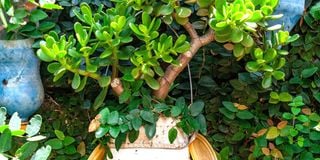
A potted jade plant at Betty Kibaara’s garden in Kerarapon, Kajiado County on May 31, 2024.
Photo credit: Billy Ogada | Nation Media Group
I see a lot of snails sitting on the leaves of flowers and trees. I am curious to know if they are a nuisance. Well, her answer surprises me.
“If you want to know a good garden, it is one that is diverse, the more diversity you have, the better your garden is,” she says.
With such a garden, having plenty of water for irrigation is crucial. “Water is important; I don’t want to take any risks. I have rainwater, tap water and community water,” she says.
The special thing about her garden is that it combines beauty with food. What she calls diversity.
“Where else would you find more than 200 species of flora and fauna? And the fact that it’s not structured, it’s all diverse, with a mix of fruits, flowers and plants,” she boasts.
Is she happy with the development of her garden?
“We host events and artists also use the space to record their videos. I also spend a lot of time in the garden and feel good about it,” says Betty.
She has spent no more than Sh20,000 on the garden so far.
“It would have been more, but my learned farming skills saved the day,” says the certified agricultural economist.
No one cuts a flower from her garden without asking her first. Her next project is to name all the plants in her garden.
Our conversation is interrupted by a rat-a-tat. She points to some birds perched on an old tree.
This is a common occurrence in her garden. “They complete the ecosystem,” she says. There is, however, one challenge. “We have to net the strawberries because they eat a lot of them.”
While her journey seems so beautiful, Betty has had her fair share of challenges, which she says have made her stronger. Her biggest challenge is the whiteflies, which feed on the undersides of plant leaves.
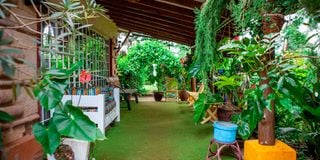
A view of Betty Kibaara’s veranda at her home in Kerarapon, Kajiado County on May 31, 2024.
Photo credit: Billy Ogada | Nation Media Group
“When I started, I made a lot of mistakes, but it turned out well. Now I have mastered the art of plants and the weather. I can tell which flower will bloom where and which will wither,” she says.
To add more art to her space, she plans to add a little bit of the art world, consisting of animal sculptures like the elephant.
Final words? “The most important thing in gardening is patience,” says the mother of two.
